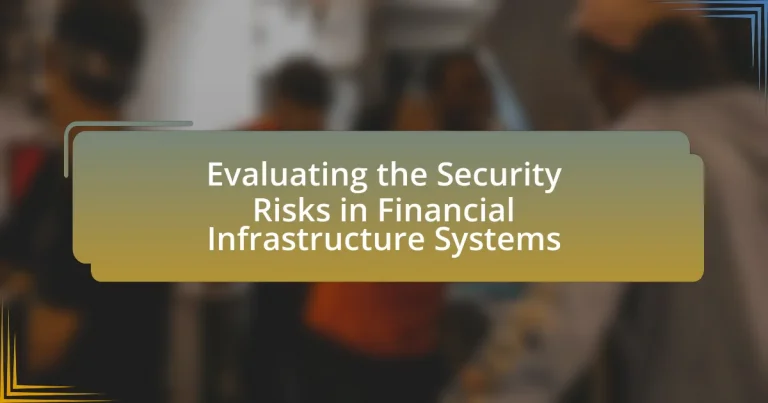The article focuses on evaluating the security risks in financial infrastructure systems, highlighting key threats such as cyberattacks, data breaches, insider threats, and system vulnerabilities. It discusses the significant impact these risks have on financial institutions, including increased operational costs, reputational damage, and potential regulatory penalties. The article also examines the consequences of security breaches, the importance of customer trust, and the methodologies for assessing security posture. Furthermore, it outlines best practices for risk evaluation, the role of technology in enhancing security measures, and the necessity of regular audits and employee training to mitigate risks effectively.

What are the key security risks in financial infrastructure systems?
The key security risks in financial infrastructure systems include cyberattacks, data breaches, insider threats, and system vulnerabilities. Cyberattacks, such as Distributed Denial of Service (DDoS) attacks, can disrupt services and lead to significant financial losses; for instance, the 2016 DDoS attack on Dyn affected numerous financial institutions. Data breaches expose sensitive customer information, with the 2017 Equifax breach affecting 147 million individuals, highlighting the risks associated with inadequate data protection. Insider threats, where employees misuse access to systems, can lead to fraud or data theft, as seen in various cases of financial fraud. Lastly, system vulnerabilities, often due to outdated software or inadequate security measures, can be exploited by attackers, as evidenced by the 2017 WannaCry ransomware attack that impacted numerous organizations globally.
How do these risks impact financial institutions?
Risks significantly impact financial institutions by increasing operational costs, reducing profitability, and potentially leading to regulatory penalties. For instance, cybersecurity threats can result in data breaches, which not only incur immediate financial losses but also damage the institution’s reputation, leading to a decline in customer trust and business. According to a report by IBM, the average cost of a data breach in 2021 was $4.24 million, highlighting the financial burden these risks impose. Additionally, compliance failures due to inadequate risk management can lead to fines and sanctions, further straining financial resources. Thus, the interplay of these risks creates a challenging environment for financial institutions, necessitating robust risk management strategies.
What are the potential consequences of security breaches?
Security breaches can lead to significant financial losses, reputational damage, and legal consequences for organizations. Financial losses may arise from direct theft of funds, costs associated with remediation, and potential fines imposed by regulatory bodies. For instance, the 2017 Equifax breach resulted in an estimated cost of $4 billion, including legal fees and settlements. Reputational damage can erode customer trust, leading to decreased business and long-term impacts on market position. Legal consequences may include lawsuits from affected parties and regulatory penalties, as seen in the case of Target’s 2013 data breach, which resulted in a $18.5 million settlement with 47 states. These consequences highlight the critical need for robust security measures in financial infrastructure systems.
How do security risks affect customer trust and confidence?
Security risks significantly undermine customer trust and confidence by creating perceptions of vulnerability and unreliability in financial systems. When customers perceive that their sensitive information, such as personal data and financial details, is at risk of being compromised, they are less likely to engage with or rely on those systems. For instance, a study by the Ponemon Institute found that 70% of consumers would stop using a service after a data breach, highlighting the direct correlation between security incidents and customer retention. Additionally, the 2021 Cybersecurity Breaches Survey indicated that 39% of businesses reported a negative impact on customer trust following a security breach. This data underscores the critical importance of robust security measures in maintaining customer confidence in financial infrastructure systems.
What types of threats are prevalent in financial infrastructure systems?
Prevalent threats in financial infrastructure systems include cyberattacks, insider threats, and operational risks. Cyberattacks, such as Distributed Denial of Service (DDoS) attacks and ransomware, target the availability and integrity of financial services, with incidents like the 2016 DDoS attack on Dyn demonstrating their potential impact. Insider threats arise from employees or contractors who may misuse access to sensitive information, as evidenced by the 2013 Target data breach, which involved insider negligence. Operational risks encompass failures in processes, systems, or external events, highlighted by the 2008 financial crisis, which revealed vulnerabilities in risk management practices across financial institutions.
What is the role of cyberattacks in financial security risks?
Cyberattacks significantly contribute to financial security risks by compromising sensitive data, disrupting operations, and undermining trust in financial institutions. These attacks can lead to substantial financial losses; for instance, the 2020 Cybersecurity Ventures report estimated that global cybercrime costs would reach $10.5 trillion annually by 2025. Additionally, the 2021 IBM Cost of a Data Breach Report indicated that the average cost of a data breach in the financial sector was $5.72 million, highlighting the financial impact of such incidents. Cyberattacks can also result in regulatory penalties and reputational damage, further exacerbating financial risks for affected organizations.
How do insider threats contribute to security vulnerabilities?
Insider threats contribute to security vulnerabilities by exploiting access privileges to sensitive information and systems. Employees or contractors with legitimate access can intentionally or unintentionally compromise security through actions such as data theft, sabotage, or negligence. For instance, a study by the Ponemon Institute found that 60% of organizations experienced an insider attack, highlighting the significant risk posed by individuals who have insider knowledge and access. This access allows them to bypass traditional security measures, making it easier to manipulate or exfiltrate data without detection.

How can financial institutions assess their security posture?
Financial institutions can assess their security posture by conducting comprehensive security assessments that include vulnerability assessments, penetration testing, and risk assessments. These evaluations help identify weaknesses in their systems and processes, allowing institutions to understand their exposure to potential threats. For instance, a study by the Ponemon Institute found that organizations that regularly conduct security assessments reduce the likelihood of a data breach by 50%. Additionally, implementing frameworks such as the NIST Cybersecurity Framework provides a structured approach to evaluate and improve security measures, ensuring compliance with industry standards and regulations.
What methodologies are used for risk assessment?
Risk assessment methodologies include qualitative analysis, quantitative analysis, and hybrid approaches. Qualitative analysis involves subjective judgment to evaluate risks based on experience and expertise, often using tools like risk matrices. Quantitative analysis employs statistical methods to measure risk in numerical terms, such as calculating the probability of an event and its potential impact. Hybrid approaches combine both qualitative and quantitative methods to provide a comprehensive risk assessment. These methodologies are essential in evaluating security risks in financial infrastructure systems, as they help identify vulnerabilities and prioritize risk management efforts effectively.
How do qualitative and quantitative assessments differ?
Qualitative and quantitative assessments differ primarily in their approach to data collection and analysis. Qualitative assessments focus on understanding subjective experiences, opinions, and motivations through methods such as interviews and open-ended surveys, while quantitative assessments rely on numerical data and statistical analysis to measure and compare variables. For instance, in evaluating security risks in financial infrastructure systems, qualitative assessments might explore user perceptions of security measures, whereas quantitative assessments would analyze incident reports and statistical trends in breaches. This distinction is crucial as qualitative data provides context and depth, while quantitative data offers measurable evidence, enabling a comprehensive evaluation of security risks.
What tools are available for conducting security assessments?
Tools available for conducting security assessments include vulnerability scanners, penetration testing tools, and security information and event management (SIEM) systems. Vulnerability scanners like Nessus and Qualys help identify security weaknesses in systems and applications. Penetration testing tools such as Metasploit and Burp Suite allow security professionals to simulate attacks and assess the effectiveness of security measures. SIEM systems like Splunk and IBM QRadar aggregate and analyze security data to detect and respond to threats in real-time. These tools are essential for evaluating security risks in financial infrastructure systems, as they provide comprehensive insights into potential vulnerabilities and threats.
What are the best practices for evaluating security risks?
The best practices for evaluating security risks include conducting a comprehensive risk assessment, implementing a threat modeling process, and regularly updating security policies. A comprehensive risk assessment identifies vulnerabilities, threats, and potential impacts on financial infrastructure systems, ensuring that all aspects of security are considered. Threat modeling helps in understanding how potential attackers might exploit weaknesses, allowing organizations to prioritize their defenses effectively. Regularly updating security policies ensures that they remain relevant in the face of evolving threats and compliance requirements. According to the National Institute of Standards and Technology (NIST) Special Publication 800-30, these practices are essential for maintaining a robust security posture in financial systems.
How often should financial institutions conduct security evaluations?
Financial institutions should conduct security evaluations at least annually. This frequency aligns with regulatory requirements and industry best practices, which emphasize the importance of regular assessments to identify vulnerabilities and ensure compliance with standards such as the Payment Card Industry Data Security Standard (PCI DSS) and the Gramm-Leach-Bliley Act (GLBA). Additionally, the evolving threat landscape necessitates more frequent evaluations, especially after significant changes in technology or operations, to mitigate risks effectively.
What role does employee training play in risk evaluation?
Employee training plays a critical role in risk evaluation by equipping staff with the knowledge and skills necessary to identify, assess, and mitigate potential security threats. Trained employees are more likely to recognize vulnerabilities in financial infrastructure systems, enabling proactive measures to be taken before incidents occur. Research indicates that organizations with comprehensive training programs experience a 70% reduction in security breaches, highlighting the effectiveness of training in enhancing risk awareness and response capabilities.

What strategies can mitigate security risks in financial infrastructure systems?
Implementing multi-layered security protocols is essential to mitigate security risks in financial infrastructure systems. These protocols include encryption, access controls, and continuous monitoring to protect sensitive data and transactions. For instance, the use of end-to-end encryption ensures that data remains secure during transmission, while role-based access controls limit user permissions based on their specific needs, reducing the risk of unauthorized access. Additionally, continuous monitoring and anomaly detection systems can identify suspicious activities in real-time, allowing for prompt responses to potential threats. According to a report by the Financial Stability Board, financial institutions that adopt comprehensive security frameworks experience significantly fewer breaches, underscoring the effectiveness of these strategies in enhancing security.
How can technology enhance security measures?
Technology can enhance security measures by implementing advanced systems such as biometric authentication, encryption, and artificial intelligence for threat detection. Biometric authentication, which uses unique physical characteristics like fingerprints or facial recognition, significantly reduces unauthorized access, as evidenced by a study showing that biometric systems can decrease identity fraud by up to 99%. Encryption protects sensitive data during transmission and storage, ensuring that even if data is intercepted, it remains unreadable without the proper decryption key. Furthermore, artificial intelligence can analyze vast amounts of data in real-time to identify unusual patterns indicative of security breaches, with research indicating that AI-driven systems can improve threat detection rates by over 50%. These technological advancements collectively strengthen the security framework of financial infrastructure systems, making them more resilient against evolving threats.
What are the benefits of implementing advanced encryption techniques?
Implementing advanced encryption techniques enhances data security by protecting sensitive information from unauthorized access and breaches. These techniques, such as AES (Advanced Encryption Standard) and RSA (Rivest-Shamir-Adleman), ensure that even if data is intercepted, it remains unreadable without the appropriate decryption keys. According to a report by the Ponemon Institute, organizations that employ strong encryption practices experience 50% fewer data breaches compared to those that do not. This reduction in breaches not only safeguards customer trust but also minimizes financial losses associated with data theft, regulatory fines, and reputational damage.
How do firewalls and intrusion detection systems protect financial data?
Firewalls and intrusion detection systems (IDS) protect financial data by monitoring and controlling incoming and outgoing network traffic based on predetermined security rules. Firewalls act as barriers between trusted internal networks and untrusted external networks, blocking unauthorized access while allowing legitimate traffic. For instance, a firewall can prevent malicious actors from accessing sensitive financial information by filtering out harmful data packets.
Intrusion detection systems complement firewalls by actively monitoring network traffic for suspicious activities or policy violations. When an IDS detects potential threats, it generates alerts for security personnel to investigate further. This proactive approach helps in identifying and mitigating threats before they can compromise financial data. According to a report by the Ponemon Institute, organizations that deploy both firewalls and IDS experience a 30% reduction in data breaches, highlighting their effectiveness in safeguarding sensitive information.
What organizational policies can strengthen security frameworks?
Organizational policies that can strengthen security frameworks include implementing a comprehensive data protection policy, establishing access control measures, and conducting regular security training for employees. A comprehensive data protection policy ensures that sensitive information is handled securely, reducing the risk of data breaches. Access control measures, such as role-based access and multi-factor authentication, limit unauthorized access to critical systems, thereby enhancing security. Regular security training for employees raises awareness about potential threats and promotes best practices, which is essential in mitigating human error, a leading cause of security incidents. According to the Ponemon Institute’s 2021 Cost of a Data Breach Report, organizations that conduct regular employee training can reduce the average cost of a data breach by approximately $1.76 million.
How can incident response plans minimize damage from breaches?
Incident response plans minimize damage from breaches by providing a structured approach to identifying, managing, and mitigating security incidents. These plans enable organizations to quickly detect breaches, contain the impact, and recover systems, thereby reducing the duration and severity of the incident. For instance, a study by the Ponemon Institute found that organizations with an incident response plan can reduce the average cost of a data breach by approximately $1.23 million compared to those without a plan. This demonstrates that effective incident response strategies not only limit immediate damage but also enhance overall resilience against future threats.
What is the importance of regular security audits and compliance checks?
Regular security audits and compliance checks are crucial for identifying vulnerabilities and ensuring adherence to regulatory standards in financial infrastructure systems. These processes help organizations detect security weaknesses before they can be exploited, thereby reducing the risk of data breaches and financial losses. For instance, a study by the Ponemon Institute found that organizations that conduct regular security audits can reduce the average cost of a data breach by approximately $1.23 million. Furthermore, compliance checks ensure that organizations meet legal and industry standards, which can prevent costly fines and enhance customer trust. Thus, regular audits and compliance checks are essential for maintaining robust security and operational integrity in financial systems.
What practical steps can financial institutions take to improve security?
Financial institutions can improve security by implementing multi-factor authentication (MFA) for all user access. MFA significantly reduces the risk of unauthorized access, as it requires users to provide multiple forms of verification before gaining entry to sensitive systems. According to a study by the Cybersecurity & Infrastructure Security Agency, organizations that use MFA can block 99.9% of automated cyberattacks. Additionally, financial institutions should conduct regular security audits and vulnerability assessments to identify and address potential weaknesses in their infrastructure. This proactive approach helps in mitigating risks before they can be exploited. Furthermore, providing ongoing security training for employees enhances awareness and reduces the likelihood of human error, which is a common factor in security breaches.
How can collaboration with cybersecurity experts enhance security measures?
Collaboration with cybersecurity experts enhances security measures by integrating specialized knowledge and skills that address complex threats. Cybersecurity experts possess advanced understanding of vulnerabilities and attack vectors, enabling organizations to implement tailored security protocols. For instance, a study by the Ponemon Institute found that organizations employing cybersecurity professionals experienced 50% fewer data breaches compared to those without such expertise. This collaboration leads to proactive risk assessments, continuous monitoring, and the development of incident response strategies, ultimately strengthening the overall security posture of financial infrastructure systems.
What are the key elements of a robust security training program for employees?
A robust security training program for employees includes comprehensive content coverage, regular updates, interactive training methods, and assessment mechanisms. Comprehensive content coverage ensures that employees understand various security threats, such as phishing, malware, and social engineering, which are critical in the financial sector where data breaches can lead to significant financial losses. Regular updates to the training materials keep employees informed about the latest security trends and threats, as the cybersecurity landscape is constantly evolving. Interactive training methods, such as simulations and role-playing, enhance engagement and retention of information, making employees more adept at recognizing and responding to security incidents. Finally, assessment mechanisms, including quizzes and practical exercises, evaluate the effectiveness of the training and identify areas for improvement, ensuring that employees are well-prepared to protect sensitive financial information.


